Accessible Medical Equipment and Furniture
Accessible Medical Equipment and Furniture
- Examination Tables and Chairs
- Lifts for Shifting Persons with Locomotor Disability
- Portable floor lift
- Over head track lift
- Lift mounted on a frame fixed to ground
- Lift mounted on a free (not fixed to ground) frame
- Gynaecological examination table
- Radiological Diagnostic equipment
- Weighing scales
- Commodes and shower transfer benches
- Complementary and Alternative medicine Equipment and furniture
- Hospital cribs and incubation units
- Ophthalmology and Optometry Chairs and Tables
- Dental Chair
- Birthing chairs
- Infusion Recliners
- Hospital Beds
- Gurneys or wheeled stretcher
- Infusion pumps
Many of the medical equipment and furniture, as physical objects, are usuallyaccessible to all persons with disabilities. But some medical equipment and furniture have features, which make them inconvenient to be used for or by persons with disabilities. To make them accessible these features are either modified or removed and additional features may be provided. Some equipment and furniture specifically designed for persons with disabilities are easier to be usedby other persons also. If accessible equipment and furniture are available, their use depends highly on structural dimensions of the rooms and other constructed structures in which they are installed or housed. For example use of an accessible patient examination chair requires easy access to the examination room and sufficient space in the room to maneuver the wheelchair. Similarly, a ceiling track lift requires a strong ceiling structure. Along with this, their use also depends on training of manpower that uses them. From patients’ point of view, accessibility requirements remain the same whether the healthcare facility is large or small or the use of an equipment is for diagnostic or therapeutic purposes. It largely depends on what services the patient wants to avail.
Accessible medical equipment and furniture are so closely linked to providing health care to persons with disability that they need maximum focus while planning for accessible medical services. Because of lack of accessible medical equipment and furniture the patient may hesitate in accessing and the service provider in providing healthcare. For example, if the examination table in the examination room is not accessible the patient may not like to be helped every time he visits the facility, so may avoid getting the services as far as possible. In absence of accessible diagnostic equipment, physicians may perceive barriers in taking care of patients with disability. A medical examination table must have required height for easy transfer and examination. For that, height adjustability makesan examination table more accessible to the patients. To have an examination table with feature that make it accessible only is not enough, it will not be accessible if there is not enough space in the room for maneuvering a wheel chair.
In a patient examination room, diagnostic procedure roomor a treatment procedure room, space is an important architectural factor. In addition to the space required for examination or treatment table, adequate space is also required for transferring the patient which can betable’s side transfer or the end transfer. If a person’s help is required in transfer of a patient to a table or bed, additional space is required for the helping person to stand on the opposite side of the table or bed. Space is also required for using a patient hoist for transferring a patient. If a portable hoist cannot be used because of space constraint and the patient is to be transferred frequently a ceiling lift may be an option.For an accessible medical facility, it is required to follow both, the regulations for medical equipment and furniture as well as regulations for architectural modifications.
Examination Tables and Chairs
Examination tables are used for examining the patients in supine, prone or side-lying position. Most of the examination or treatment tables in the healthcare facilities are with fixed height of 800mm.Persons with locomotor disability find it difficult to transfer themselves independently from their wheelchair onto the tables and vice-versa. Sometimes, even some standingpatients find it difficult to get onto the table.

- The examination table should be with adjustable height with minimum height of 400mm to500mm.
- Two major advantages of height-adjustable tables are that they make patients’ transfers easier and safer compared to fixed-height tables. They also help the physician in examination by providing the required height.
- The table should also have adjustable head and back support through the entire inclination range.
- The tables should have good enough cushioning on top to prevent pressure sores.
- They should be with removable side rails to prevent falls.If required additional safety stirrups, straps and neck supports option should be available
- They should have sufficient length and width for easy lying, turning and transfers.
- The transfer board surface usually needed is 1000 mm X 400 mmwhich prevents it from rotating.
- People using mobility devices must be able to transfer safely and easily to and from your exam tables and chairs.
- They should have a remote to adjust the height using powered bed position and height controls and call buttons.
- Required accessories may be leg supports, articulating knee crutches, stirrups with flexible degrees of freedom for pelvic examination etc.
- The table should be with minimum clearance of 150 mm above the floor and the equipment overhangs clearance. The clearance permits a portable floor lift to be used for transferring patients.
- Minimum clear floor space of 800mm X 1250mm next to exam tables is required for easy transfer of patients onto the tables.
- The weight capacity of the table should be about 250-400 kgs.
Lifts for Shifting Persons with Locomotor Disability
Portable floor lift
These lifts are easy to be carried to different rooms and areas of the healthcare facility which can’t be done with the other types of lifts, the ceiling mounted or floor fixed lifts. They usually require space under the table or bed for its legs or base. These can be used as portable weighing scales as well for the patients that find sitting in a wheelchair difficult. When the base width is made adjustable the legs can be positioned both under and by the side of examination table or a chair depending on requirement.
Over head track lift
There are three types of overhead lifts: Ceiling mounted lift, lift mounted on aframe which is fixed to floor and lift wich is not fixed to floor.
Ceiling mounted lifts are fixed structures where lift is attched to a motorised structure which moves on a track fixed to ceiling. This does not require extra space on floor for wheelchair maneuveing, so the rooms that do not have space for wheelchair mobility but are to be modified for patient , this type of lift is useful. Disadvantages of this type of lift are that it can not be moved to another room room and is costly. The ceiling structure should be strong enough to take load of both the lift and the patient.
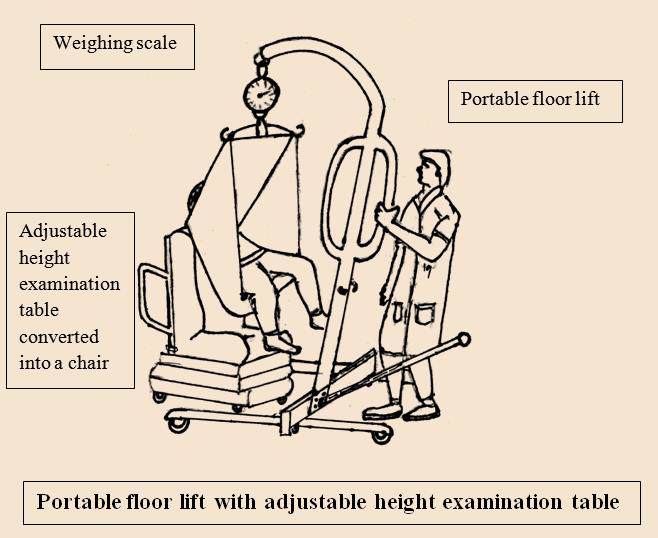
Lift mounted on a frame fixed to ground
These lifts also can not be moved to other rooms. These lifts require less space than the free standing movable lifts. They usually do not need the space required by free standing and portable lifts so are suitable for small rooms.They do not need the ceiling to be strong and do not require any structural changes.
Lift mounted on a free (not fixed to ground) frame
These lifts can be moved to other rooms but require more efforts than the portable patient lift. These lifts require less space than the portable lifts. They usually require space for base of the lift, so are suitable for small rooms.They do not need the ceiling to be strong and do not require any structural changes.
Gynaecological examination table
- Gynaecological examination requiring specialised positions must be accessible to a woman with disability.
- To provide accessible gynaecological examination to a woman with paralysis or other conditions who finds it difficult to move or support her legs, an examination table with adjustable padded leg supports instead of typical stirrups should be available.
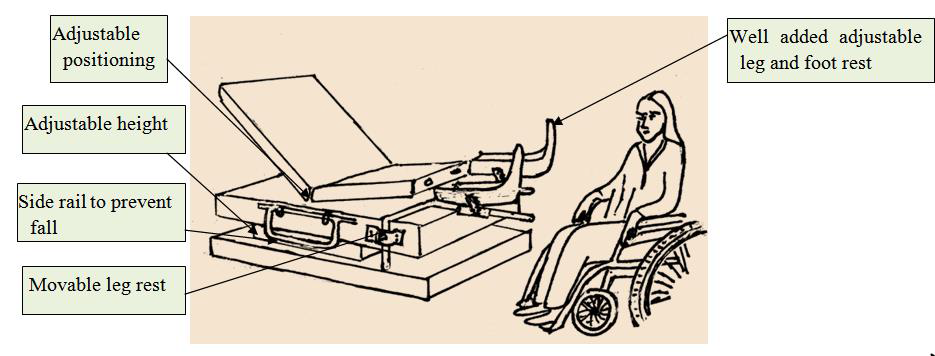
Radiological Diagnostic equipment
Persons with disabilities having weakness or spasticity of muscles, balance problems or structural posture problems etc. can’t be positioned on certain radiological diagnostic equipment like MRI, CT, DEXA Scan, Mammography etc. or they find it difficult to use. Some specific changes in design or provision of accessory features can make them easier to be used by persons with disabilities. Following are some of the common features that can be incorporated in the equipment to make them accessible:
- Equipment with height adjustment for easy transfer of the patient and width adjustment for comfortable change in position from prone to side lying or supine.
- Large opening of CT or MRI machine.
- Visual signals
- Commands in loud and clear voice
- Presence of straps to stabilize position
- Side rails for support to prevent falls and stabilize his or her position to get good quality report.
- Ceiling mounted x-ray equipment can save the space for wheelchair mobility in a smaller space.
- C-arm and CXDI series of X-ray devices may be quite helpful in getting good quality X-rays when positioning of a person with disability is a problem.
Mammography equipment and Chairs
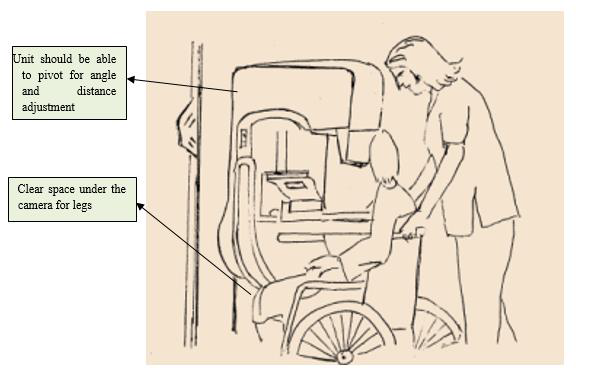 For mammography of a person with disability a wheelchair with folding arm rests may be good enough. Ifa patient is brought for mammography in a wheelchair with fixed arm rests,a mammography chair with adjustable seat height that lowers to a minimum height of 500 mm to550 mm, adjustable seat depth, reclining seat back and removable or folding arm rests is useful.
For mammography of a person with disability a wheelchair with folding arm rests may be good enough. Ifa patient is brought for mammography in a wheelchair with fixed arm rests,a mammography chair with adjustable seat height that lowers to a minimum height of 500 mm to550 mm, adjustable seat depth, reclining seat back and removable or folding arm rests is useful.
For diagnostic mammography
- There should be sufficient clear knee space from the stand to the front edge of the imaging receptor to enable wheelchair users to go into position for mammography without running into protruding imaging platforms or tube heads connected to the central stand. The imaging receptor should beadjustable upto the lower level of 600mm from floor. Position stabilising straps and pillows etc. should be available as accessories.
- Some patients need support to lean forward.
- The unit should have provision to pivote for angle and distance adjustment.
- The path to the equipment need to be accessible.
- The position of the equipment should allow forward, side as well as angled approach.
Densitometer with adjustable height stretcher
Most of densitometer are with fixed height, so a gurney with adjustable height upto lower level of 450 mm from floor heightwhich is the level of wheelchair seat is required.
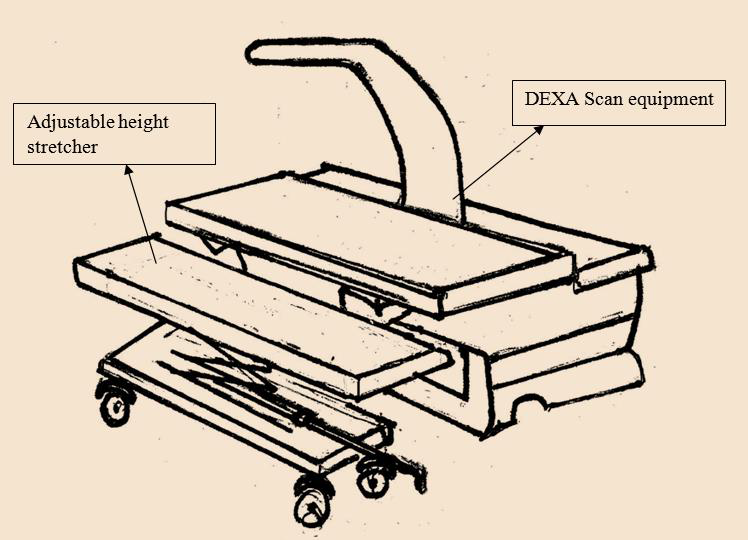
Weighing scales
 Weighing a patient is needed in management of many medical conditions like Obesity, Diabetes mellitus,Cancer etc. Using a normal weighing scale may be difficult for a person in wheelchair as the wheelchair can’t be taken onto the platform of the equipment. Accessible weight scales should have the following features:
Weighing a patient is needed in management of many medical conditions like Obesity, Diabetes mellitus,Cancer etc. Using a normal weighing scale may be difficult for a person in wheelchair as the wheelchair can’t be taken onto the platform of the equipment. Accessible weight scales should have the following features:
- A platform onto which a wheel chair or scooter can be taken up and stabilized. The width and length of the platform should be sufficient for the purpose.
- The surface of the scale should not be slippery and should not allow the wheelchair to move if stabilized so should have slip resistant platform with high contrast edges.
- The weighing capacity of the scale should be high i.e.a minimum of 250 kg.Weight of a wheelchair or a scooter should be easy to be calculated.
- It should have a large digital display with sound announcing the weight.
- For a patient who needs support for standing, the scale should have hand rails.
Accessible weighing scales that are integrated into other medical equipment as into a hoist or a bedare also available. There are weighing scales that are foldable and portable. With the provision of accessible weighing scale, the staff weighing the patient should be trained for the purpose.
Commodes and shower transfer benches
The shower benches and commode chairs should have following features:
- Portable with folding support rails
- Facility to transfer laterally
- Height adjustability
- Non-slippery legs
- Padded seat to prevent pressure sores.
- Easy transferability by sliding or rotating the seat
- Convertibility of shower transfer bench into commode by taking out theremovable part of the bench.
Complementary and Alternative medicine Equipment and furniture
A standard medical facility for complementary and alternative medicine treatment requires
- Apatient examination and treatment table with height adjustment upto minimum height of 400-450mm and withsufficient width for safe transfer and positioning
- Supportive cushions, straps and rails
For treatment like massage and some other ayurvedic treatment, the tables are typical and are available in market but they should have all the accessibility features.
Hospital cribs and incubation units
The area should be accessible to the mother with disabilities for breastfeeding, bonding and comfort giving.
The cribs and incubation units should have legswith adjustable heights to provide required leg space to a mother in wheelchair to approach her baby.
Ophthalmology and Optometry Chairs and Tables
An accessible ophthalmic chair should have following features:
- For ophthalmological examination of persons with disability the examination chair’s height should be adjustable to lower level of 450 cm for independent transfer from wheelchair to the examination chair.
- Sufficient space is required around the chair for the independent transfer to maneuver the wheelchair.
- Transfer from wheelchair may need portable hoist or patient lift.
- The chairs are usually fixed to floor to access the refractive equipment easily so wheelchair maneuvering space is required.
- The ophthalmologist’s chair should be easily maneuverable in the space available so that the examination is possible while the person is sitting in wheelchair.
- Height of the chair should be adjustable with minimum height of 400-450mm from floor to the top of seat.
- The floor rest should be movable and detachable.
- Arm rests should be foldable or removable.
Dental Chair
 Dental examination and procedures for preventive or curative purposes require a dental chair. The accessible dental chair should have following features:
Dental examination and procedures for preventive or curative purposes require a dental chair. The accessible dental chair should have following features:
- Provision to set at different angles of inclination
- Adjustable height with minimum height of 400-450mm for easy independent transfer from a wheelchair.
- A reclining seat along with reclining back is useful in positioning of knees in 90 degrees.
- Accessories like belts and straps
- Adjustable dental equipment and light source to be used at different height even for a patient who is in a wheelchair.
- Wherever possible it is preferable to use a wheelchair lift which positions the patient in a wheelchair so that dental examination and procedures can be done without shifting the person to a dental chair.
Birthing chairs
Some centres use birthing chair for vaginal delivery in place of hospital bed. The accessible birthing chairs are of two types
Fixed height and back rest type
- The seat of the chair should be at the level of wheelchair
- The arm rest should be foldable
Adjustable height and back rest type
- Adjustable height of the chair to minimum height of 400-450mmfrom floor to the top of seat
- Movable and detachable foot rest. Foot rests should be adjustable to squatting position.
- Removable and swing out type arm rests with bars
- A reclining seat along with reclining back which is useful in positioning of knees in 90 degrees.
- Leg suspenders for lithotomic position
- Accessories like belts and chest straps etc.
Infusion Recliners
Infusion recliner chairs are used for many purposes like receiving chemotherapy, donating blood, day care recovery etc. Some treatments require the patient to stay in the chair for long period upto 12 hrs so the recliner need to be comfortable.
The accessible recliner should have following features:
- Adjustable height with minimum height of 400 to 450 mm for easy independent transfer from a wheelchair.
- A reclining back
- Swing away and removable arm rests
- Cushioned leg support
- A good quality comfortable seat cushion.
Hospital Beds
An accessible hospital beds should have following features:
- Level of bed should be adjustable for easy transfer onto stretchers or wheelchairs etc.
- It should be easy to get in and out of bed.
- Adjustable bed height to bring down the bed up to the height of 400 to 450 mm between ground and the top of mattress for easy transfer from bed to wheelchair and vice-versa.
- It should have removable and folding side railings to prevent falls.
- There should be clear vertical space under the bed to accommodate legs of portable equipment like a patient lift.
- Mattress should be thick enough for pressure sore prevention.
- The beds should be motorized with remote operated bed height and position control.
- They should be operable by persons with limited or no range of reach, limited vision or fine motor ability
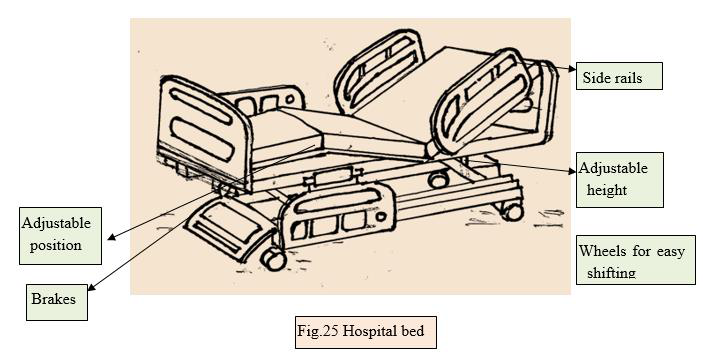
Gurneys or wheeled stretcher
They are used for transfer of patients in hospitals for diagnostic and treatment procedures such as ultrasound examination, ECG, catheterization etc. Some equipment like x ray equipment and DEXA scan equipment in radiology department do not have space under them for the portable floor lifts to be used and sometimes the metallic part of the lift is not compatible with the procedure so they can’t be used.
In such cases stretchers or gurneys which are tables on wheels and have height adjustment provision, can be used for both bringing and transferring the patients, if required with sliding board. They should have the following features:
- Extra width,upto about 1000 mm
- Ability to bear weight of up to 250 kg.
- Provision to adjust heightto the lower level upto 400 mm above the floor surface to bring its top to the level of the surface onto which the person with disability is to be transferred to or to a wheelchair seat.
- Sufficient length to make transfers easy.
- Safety straps and folding rails to prevent falls
- Lockablewheels to prevent sliding or moving during a transfer of a person with disability.
Infusion pumps
- To administer needed nutrients or medications in the comfort, convenience, and privacy of one’s own home the pumps used by disabled should have:
- Universally designed high contrast colour and raised lettering controls
- Switches in place of small closely set arrangement on the screen
- Provisions to set auditory, visual and tactile (e.g., vibration) alerts.
- Newer infusion pumps infusion rate can be controlled using computer or mobiles
RehabilitationEquipment
- The accessible exercise machines and equipment like treadmills, multi-exercise stations, upper and lower body resistance stations, rowing machine, recumbent cycle, elliptical cycle, upright cycles, vibration training and upper body ergometer should have the followingadditional features:
- Large bright buttons
- Display on screens should be with large text size.
- Indictors should be audible and visible.
- There should be audible and visible warning signals.
- There should be contrast colour grips and levers and raised iconography on their consoles.
- The equipment should have a logo or picture on the treadmill belt in contrasting colours and good contrast between the belt and the metal surface to recognise that the belt is moving.
- The exercise equipment should have a swing seat with slow starting speed.
- The access to the equipment should be easy for wheelchair users.
- Feature of single hand seat adjustment is useful.
- Treadmill should be with emergency stop system.
- Recumbent cycle should be with a step through design and machines with paddles with fixed heel strap and adjustable toe strap.
- Elliptical cycle should be with good locking mechanism.
- Wherever possible, equipment with universal design features is always better.
Source : Ministry of Health & Family Welfare
Last Modified : 6/10/2023
This topic provides information about Accessible a...
Provides information about MyHealthRecord
This topic provides information about Converting F...
This topic provides information about Rashtriya Ki...
